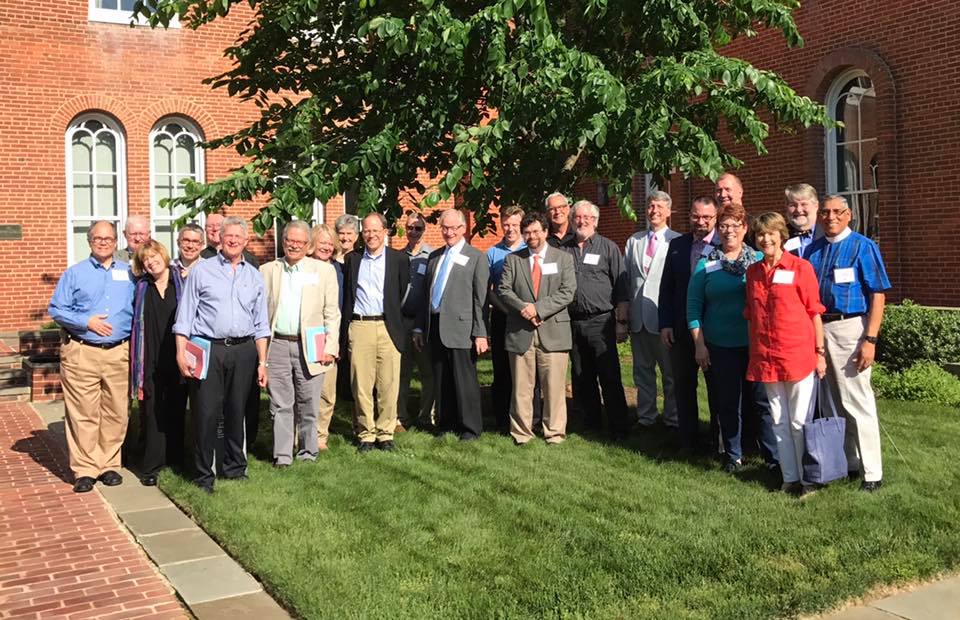Guest Blogger Martha B. Alimi is a PhD candidate in theology at Boston University’s School of Theology, and the Music Director at Christ Episcopal Church in Middle Haddam, CT. She is currently writing a dissertation on Hildegard of Bingen’s theology and understanding of music, particularly as it appears in her treatise, Scivias.
New Job
This summer, I was blessed with a job as an organist and music director at a small Episcopal church in Connecticut. I reached out to this congregation, knowing that they had been without an organist for quite some time. Because of the pandemic, they were using Zoom for Sunday services. These were simple Morning Prayer services: no music, no Eucharist. In fact, they assumed that music was impossible over Zoom.
I explained that music is possible over Zoom! It’s not ideal for congregational singing, but the congregation can mute their microphones and sing along while I play and sing. This way, congregants hear at least two people singing at the same time. The priest was thrilled. She told me the congregation had been rather depressed lately. Without in-person worship, music, or Eucharist, they were chomping at the bit to go back to church. But the priest didn’t see an end to online worship in sight. Too many congregants are over 65. Too many have underlying conditions. She doesn’t want to return to the building until everyone is vaccinated. Life is too precious.
My Other Job
In my other job – writing my dissertation – I think about congregational singing alongside Hildegard’s writings. Her treatises contain powerful imagery from her visions of the triune God, as she describes God’s personal relationship with humanity and providential work of salvation. Her personal letters are driven by deep theological interests, applied to practical concerns. In these texts, Hildegard often emphasizes the importance of congregational singing – for her, singing the Divine Office. As a musician, she composed and sang liturgical chants with her fellow sisters. She had divine visions of the harmony of the cosmos. She believed that, through singing in worship, earthly choirs join their voices with heavenly choirs in praise of God — a musical foretaste of the feast to come. Inspired by the power of the Holy Spirit, she believed singing could also be prophetic and pedagogically effective.
Admittedly, there may appear to be a gulf between Hildegard, a 12th-century Roman Catholic nun, and the challenges of my little Episcopal parish in Connecticut. But as I began playing a service via Zoom in December, I suddenly saw Hildegard as a companion in these difficult times. Let me explain.
Hildegard’s Letter
In Hildegard’s 1178 letter to the Prelates of Mainz, she protested sanctions imposed on her convent by the Prelates because she allowed the Christian burial of an excommunicated nobleman. She maintained that he was reconciled to the Church before death and refused to exhume his body from consecrated ground. In response, the Prelates banned the sisters from hearing Mass, participating in the Eucharist, and singing the Divine Office. Hildegard and her fellow sisters observed the ban’s terms, but, “constricted by this heavy burden,” she vehemently argued with the powerful Prelates.[1] Inspired by her visions, Hildegard outlined the importance of the Eucharist, and then concentrated on the Prelates’ prohibition of singing. The result in the letter is a summary of Hildegard’s theology of music. Liturgical singing was fundamentally important to her life, and, she argued, to human life in general. She believed that failing to sing the Divine Office is not merely upsetting because she enjoyed singing. Rather, she argued, failing to sing the Divine Office is improper, incorrect worship. Proper worship requires singing. Ultimately, Hildegard persuaded the archbishop to vindicate her when he returned from Rome. In the meantime, however, Hildegard and her sisters suffered deeply from the loss of liturgical singing and the Eucharist.
Instead of a ban from Prelates, the pandemic caused my little Episcopal church to suffer from the lack of music and the Eucharist. In August, I started playing a prelude, postlude, and hymns for their Sunday Zoom services. The congregation was thrilled! They sang along, and often commented on the music. These musical Morning Prayer services continued until Advent. As the congregation prepared their hearts for the Incarnation, the priest decided to celebrate Spiritual Communion. This meant returning to a Eucharistic liturgy, complete with service music (Kyrie, Sanctus, and Fraction Anthem), hymns, prelude, postlude, and Communion. Since the congregation could not physically participate in Communion over Zoom, the priest buried the consecrated elements outside in the ground. Again, the difference in the congregation’s spirit was palpable! It still wasn’t in-person worship, but the Eucharistic liturgy, accompanied by music, reignited this congregation. The longer service did not affect attendance – this was something everyone wanted. More than that, it was something everyone needed.
What We Can Learn
Hildegard was right. Without the life-giving power of congregational music and the Eucharist, Christian communities can fade. These liturgical and sacramental activities are vital to maintaining a vibrant congregation. While our pandemic is not the same as her Prelates’ sanctions, we can learn from Hildegard. We can commit to sing and to partake of the body of Christ in whatever way possible because it is necessary for the life of our congregations. Let us remember these lessons when we return to in-person worship someday.
[1] Letter 23, Hildegard to the Prelates at Mainz. …magno tandem pondere compressa…



